Network News SEPTEMBER 2021

In this issue
Feature
The Amazing Superb Fairy-wren
-Richard Cassels
Bouncing around like highly energised ping-pong balls, Superb Fairy-wrens are a continuous source of fascination and entertainment!
These birds are so small they can become trapped in spider webs, yet they are great survivors. Are they really Mormons? Do they teach their chicks passwords while still in the egg? Are they fond of cuckoos? What is their favourite habitat?
Nine Really Great Things about Superb Fairy-wrens
- They are hard to miss- both because of the bright blue of the males in summer, their continuous chattering (“a rippling reel of short notes” or “like a miniature fishing reel”), and their attraction to places near us- gardens, mulch heaps, weedy banks etc.
- They have been extensively studied. As one ecologist said: “tramping through leach-infested rainforest [is not as much fun] as teasing apart the intricate sex lives of superb fairy-wrens in the croissant-infested Botanic Gardens of Canberra”.
- In the breeding season (spring and summer) males develop their spectacular blue plumage, while females and young birds are brown. In winter however most birds are predominantly brown. One exception is males over 4 years old which can stay blue all year. One difference persists at all times of year; males have black bills and females have orange ones.

Photo above RC: Juvenile or female in winter, on the big NEV log pile ,2 July 2018.
- Opinions on the private lives of fairy wrens tell us as much about bird watchers as about the birds.
- Fairy-wrens were once called “Mormon wrens” because the blue males were thought to be accompanied by a “harem” of brown females (wishful thinking by male birdwatchers?).
- Then the brown birds were discovered to be a mix of younger males and adult females. But males did form long-lasting pair bonds with females.
- Until DNA studies were carried out, the wrens, like most birds, were thought to be monogamous. Then DNA testing showed this was far from the case.
- Next it was assumed that the “unfaithful wanderers” were males. Then radio tracking of Superb Fairy-wrens showed that it was the females who stray, flying some distance from home to visit males in the very early hours of the morning, while it is still dark.
- Perhaps this all reflects the increase in the number of female ornithologists?
- Final note: males sometimes give females yellow flowers as presents.
- Families share bringing up their chicks, and males may incubate eggs. This can allow the female to breed more than once each season.
- They are remarkable survivors, considering that: (1) they are preyed on by currawongs, magpies, butcherbirds, crows, hawks, snakes, cats, dogs and foxes; (2) they are so small that they can become trapped in spider webs; (3) their nests are parasitised by cuckoos; (4) hazard reduction for bushfires removes some of their favourite habitat.
- Females are less wary when males are around, perhaps because males are more obvious targets for predators. Correspondingly males were shown to be more wary of predators when in full blue breeding plumage.
- They communicate vocal “passwords” to their young while they are still in their eggs. This helps the adults identify any eggs laid by cuckoos or young cuckoos. Fairy-wrens really hate cuckoos and will mob them aggressively.
- Fairy-wrens mainly eat insects as well as small amounts of seeds, flowers and fruit. In winter ants are a “food of last resort”.
5 interesting facts about Superb Fairy Wrens at Narara Ecovillage
- Fairy-wrens are found only in Australia and PNG, with a total of 15 species. Australia has 9 species, all different from those in PNG.
- At NEV Superb Fairy-wrens are the most common fairy wren. Occasionally we get Variegated Fairy-wrens here. The male Variegated has distinctive chestnut shoulders, see below.
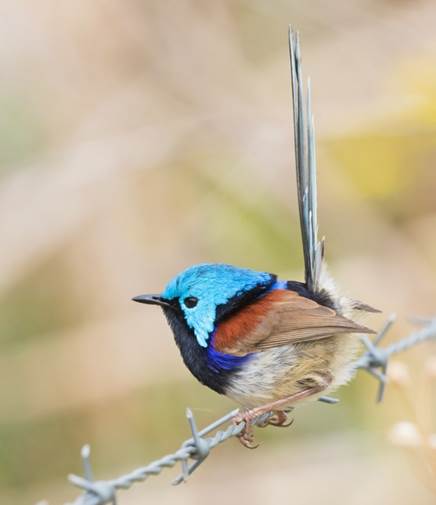
Photo above: male Variegated Fairy-wren at Central Coast Wetlands near Wyong. Photo courtesy of Christina Port, Central Coast Birders.
- Superb Fairy-wrens like to live in low, dense vegetation like reeds and long grass. At NEV they are mainly found around the floodplain, the dam and fringes of the rural lots. They are rare in the forests (except for an adventurous couple at the Header tanks discovered by Guy), where they seem to be replaced by unrelated but equally vocal Brown Gerygones.
- Because they are noisy and conspicuous, it is tempting to think that there are a lot of Superb Fairy-wrens at NEV. So I tried to count them. This is hard without tagging them, as most researchers would do. Fortunately however they sing continuously at dawn in spring. So on the morning of Saturday 11 September, between 5.15 and 30 a.m. I set out to count the birds calling. I reckoned there were at least 11 birds. If only males call, and as they often occur in pairs at this time of year, that suggests that there at least 22 birds here, plus Guy’s 2 at the Header tanks. If both sexes call, then there might only be 13. So we need to establish if females call at that time too!
- At NEV Superb Fairy-wrens (mainly insect eaters) are often seen together with Red-browed Finches (mainly seed eaters). This may be to share predator watching.
Sources:
- Jennifer Ackerman, 2020. The Bird way. A new look at how birds talk, work, play, parent and think. Scribe, Melbourne.
- Noah Strycker, 2014. The Thing with Feathers. The surprising life of birds and what they reveal about being human. Riverhead Books New York,
- Peter Menkhorst et al 2017 The Australian Bird Guide. CSIRO Publishing, Melbourne.
- Wikipedia: “Superb Fairy-wren”, viewed 10 September 2021.
- Web sites: Birds in Backyards, Birdlife Australia, Backyard Buddies.
- Alexandra McQueen and Anne Peters 2017: https://theconversation.com/it-isnt-easy-being-blue-the-cost-of-colour-in-fairy-wrens-80006
Meet Milo, Melissa and Morris: The fascinating “Blue Wrens” at Narara Ecovillage.
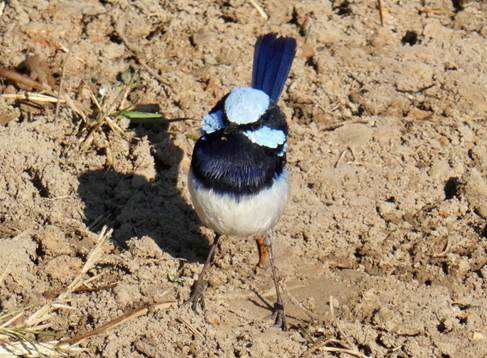
Photo above (RC): Milo the Magnificent, Lord of the Five Ways, size of a ping pong ball, challenges the photographer. (Male Superb Fairy-wren, breeding plumage, threat posture). 31-8-21.

Photo above (RC): Melissa the (not so) Modest, near the Triplespan (Female Superb Fairy-wren) 17.9.21.
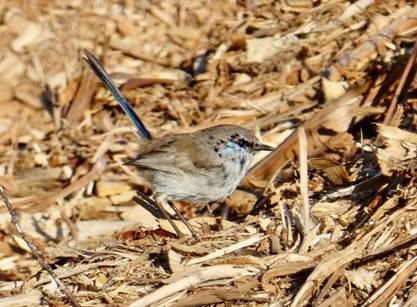
Photo above (RC): Morris the Upstart, on the mulch heaps. (Male Superb Fairy-wren developing breeding plumage) 8-9-21.
Village News
Planting for biodiversity case study: Swamp Mahogany trees at Narara
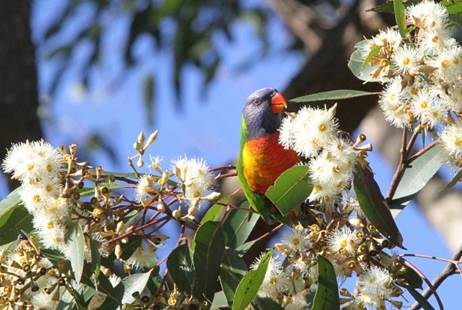
– Patricia Meagher, Guy Dutson, Richard Cassels
Planting trees at Narara Ecovillage (NEV) ticks many boxes – community engagement, carbon sink/offset, biodiversity value, re-wilding, aesthetics, summer cooling etc. Many of us are keen to get our hands dirty, but large-scale planting awaits a village-wide review of our land-use to ensure that we’re not excluding other uses such as food production.
Swamp Mahogany (Eucalyptus robusta) grows up to 30 metres and lives for at least 200 years. It flowers in winter, and its prolific nectar is an important food for many birds, such as lorikeets and honeyeaters. Other native species, such as koalas, feed on their flowers and leaves.
One mature tree in the village has had up to 40 individual birds feeding in its blossom this winter, with flying-foxes taking over at night. Although NEV is too far inland for this tree to grow commonly, it is of such ecological importance (see more notes here) that we want some more!
In 2020, a dozen Swamp Mahoganies were grown from seed by Patricia Meagher and Henry Wells in the Narara Ecovillage Nursery propagation houses.
The seeds were donated by Henry from a tree in his family’s garden. Sown on 25 February, the seedlings were potted up on 12 May, and nine months later they had grown so well that they urgently needed planting out.
So in February this year, after consultation over locations, nine of the young trees were planted on the east side of the floodplain by the village’s Flora and Fauna Conservation Working Group, which includes village members as well as local volunteers.
Using the previous experience of the group, the trees were ‘deep planted’ up to 50 cm in the soil, and protected from wallabies by 1.5 metre wire guards.
Alarmingly, four weeks later, in the flood of March 2021, all the plants and guards were bowled over. We restored the young trees to an upright position the next day, and happily they have thrived ever since. We installed much stronger stakes a few months later.
In late August 2021 Richard Cassels weeded and mulched the trees, and repaired the guards. Eight are going well, having grown strongly in the last six months, but one is stunted, possibly because it is in a very wet spot. We hope they will continue to grow into magnificent tall trees providing abundant winter food, attracting endangered species such as Swift Parrots, and eventually developing hollows for nesting birds.
We will continue to maintain and monitor these trees, and look forward to encouraging more trees and tree-planters into the future.
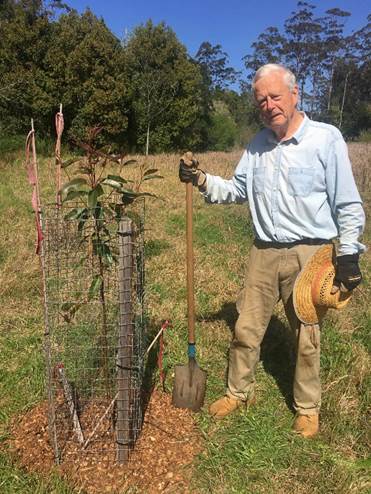
Upcoming events

Narara Ecovillage monthly Open Day: now ONLINE, Sun AUG 29, 10.30am-12pm
Brew up a Sunday morning coffee or tea and quiz our Ecovillage members on the topics you’ve always wanted to ask about but didn’t know how.
Book here to get the link & more info
When: 10.30am-12pm
Price: Free or by donation
What: Start with a general introduction to the village, then choose your conversation:
- Family living at Narara
- Legal and Finance issues
- Sustainable Building
- Culture and Community
- Collaborative Living
- Food production in the Village
Major event at the Village: Ecovillage residential Experience Weekend

Now you can experience what life is really like in an ecovillage!
About the weekend
Would you like to experience life in a dynamic, inter-generational, village eco-community, with effective self-governance, where everyone feels strongly connected with their neighbours?
Narara Ecovillage is a thriving community-under-construction, with a mission to demonstrate successful ways of living more lightly on the earth, with a focus on local, deeply connected community.
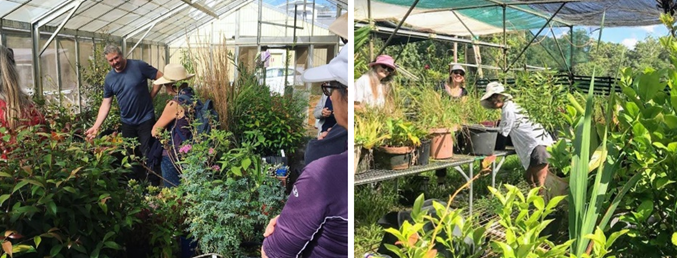
In this all-inclusive, immersive, residential weekend, you will meet, mix and learn from the fascinating range of qualified and experienced members of this vibrant community.
A stimulating program of workshops and activities will be offered, led by members of the ecovillage. These include hands-on mushroom growing, Deep Ecology with well known rainforest activist, John Seed, learning about the local smart grid, seeing the beautiful Eco homes, and joining in out-door working bees, campfire community dinners and story-telling.

Children are welcome too, and a parallel program of kids activities will be offered, including circus training and natural handicrafts.

- You can check out the details and register here
- https://nararaecovillage.com/narara-ecovillage-experience-weekend/
The Welcome

When you arrive, Friday night dinner is provided by Candy’s crew at the Coffee Cart. Candy is a passionate organic cook and café operator whose ready smile and friendly vibe makes our coffee cart sing at the centre of our village. Candy has run many different cafes, always built on a theme of community connection and circular economy. Her rich coffees and healthy home-made meals, including produce from the village, will always delight the palate. Operating with her ever good-natured son, Dave, and other village helpers, she creates a nourishing and happy buzz.
After dinner, the weekend kicks off with an opening talk by our founder, Lyndall Parris, who has travelled the world learning about other successful communities. Lyndall decided to form Narara Ecovillage because she thought, rather than just accept the way things are, why don’t we create what we want?
Then we will delve into the four pillars of Ecovillage Development and you can start sharing your passions with others. In this opening activity we will use educational tools for Ecovillage Design to help us begin unfolding our common interests and explore the question: What is an ecovillage? Social, Culture, Economy and Ecology are the four pillars of ecovillage communities. Tanya Mottl, Global Ecovillage Network (GEN) ambassador, will use GEN’s educational resources to help the group explore its wisdom, inter-connections and possibilities as we lead into the weekend.

Note: the event is scheduled for November. You can reserve your Early Bird place now, and if the date needs to be postponed, your booking and price will be retained. See details on booking page.
Check out the details and register here https://nararaecovillage.com/narara-ecovillage-experience-weekend/
Accommodation options
Accommodation is in our three or four star BnBs, run by our village members. Experience staying in one of our beautiful seven-star ecohomes or with a local family in the process of designing their sustainable home. Another option is our lovely onsite bush camping area where you can enjoy five million stars! Our pricing options all include accommodation and three meals a day — (except campers will BYO breakfast—or buy from the Coffee Cart.)
Saturday Program
Dawn Chorus
Saturday begins with an early morning walk around the Ecovillage to hear the spring morning chorus – this is an optional extra for early birds! Go walking with Richard Cassells – our Bird Officionado – before breakfast and learn to listen out for our local and diverse bird life. Richard will guide you in identifying the different bird calls and discuss their behaviours, habitat and role in the eco-system.
Grow your own mushrooms
Next you can learn to grow mushrooms in whatever space you have. In this hands-on practical workshop, with Lincoln DeKalb – the Mushroom Man, you will create your own active mushroom kit to take home. Learn about the nutritional value of mushrooms, their importance in the eco-system and how you can add them to your family menu. All materials provided.
Our local solar power grid
Next, learn how we established our own embedded energy retailer, NEV Power. How we created our own solar micro-grid, the triumphs and pitfalls, and how we are engaging the community in a profit making venture while increasing the solar energy in the NSW grid. You will be able to view our infrastructure including the village battery, metering system, and solar panels.
Community gardening
Work along side community members at our permaculture community garden. The community garden, known as the “Triple Span” for its over-arching steel structure, includes rotating vegetable beds, herbs, chook tractors, compost and future plans for outdoor educational areas and aquaponics. Join community members in helping with the next stage of these projects. Afternoon tea will be served onsite.
Visit the Eco-homes
Then join a walking tour to get a taste of the diversity of our eco-homes. Take a guided walk around the village to look and learn about the wide variety of eco building styles. You will have a chance to go inside several of our seven star rated, passive solar, energy efficient eco-homes. See how design, orientation and choice of materials can make all the difference to energy efficiency.
Campfire and Story Telling
In the evening, hear and share community stories in a facilitated campfire story telling session, with Linda Scott – Artist and Story Teller. Story telling is the oldest method of human interactions, used for many thousands of years to pass on knowledge, create understanding and build community. In this facilitated story telling session around the campfire you will hear some great yarns, get insight into the community and also yourself, as well as having a good old belly laugh.
Sunday Program
Early Bird Yoga
On Sunday, join in a yoga session before breakfast to get your day started on the right foot – sorry, yoga pun! (This is an optional activity for early birds). Discover gentle yoga, combining techniques for waking up and activating the mind, body and spirit. Suitable for beginners or intermediate students. This gentle wake-up class is engaging for the whole person, and will leave you feeling alive and ready for whatever is next.
Deep Ecology
Then you’ll be treated to John Seed’s Deep Ecology workshop, which enables us to find an end to the illusion of separation, and EXPERIENCE our rootedness in the living Earth. Deep Ecology reminds us that the world is not a pyramid with humans on top, but a web. By acknowledging our interconnectedness with all life, we invite the spontaneous healing of the psyche. In this Deep Ecology Workshop, we participate in a series of processes and rituals informed by those used by indigenous peoples throughout time.
John Seed is an author, filmmaker, lecturer, activist and founder of the Rainforest Information Centre. John has written and lectured extensively on deep ecology, conducting Council of All Beings and other re-earthing workshops world-wide for 30 years. With Joanna Macy, Pat Fleming and Arne Naess he co-authored ‘Thinking Like a Mountain: Towards a Council of All Beings’, (translated into ten languages). In 1995 John was awarded the Order of Australia Medal (OAM) for services to conservation and the environment. John is also a talented folk singer, a prolific gardener, and much loved member of Narara Ecovillage.
Biodiversity in action
You will have a chance to learn about the wonderful plants and animals of our region, and how to engage and help their conservation with Guy Dutson, our biodiversity expert. Enjoy a visual tour of some of the amazing plants and animals of our region. Learn about how we benefit from nature and how we impact it. See some ways in which to engage more deeply, and join some simple actions to help engage and conserve biodiversity for future generations.
Bushcare
Then feel the community vibe as you work alongside some of our passionate bush regenerators helping to maintain and restore some of our wild places. Trish Maegher – horticulturist and plant lover, is our go-to person whenever we need to ask, “what plant is this?” As a researcher in horticultural science, Trish has a deep knowledge of plant species and propagation methods as well as bush regeneration techniques, and was part of the team that saved and propagated the Wollemi Pine. She has been instrumental in the clearing and regeneration of our beautiful heritage gully and ongoing maintenance of the wild areas of our site. Trish will welcome you to join a working bee where you can work alongside villagers in our regular bush regeneration activities.
The Kids program
Narara Ecovillage is heaven for kids! Those who visit this weekend will have a chance to experience some of the highlights.
Circus workshops
If your kids have always wanted to join the circus, now is their chance! Kids aged five and up can learn ground based skills such as juggling, hula hoop and acrobalance. The trainers are professional circus performers who have entertained crowds in Australia and around the world.
Rachel Peters and Andy Long, operators of Roundabout Circus, a social enterprise on the Central Coast, teach circus skills to kids to help to improve confidence, self-esteem, attention span, creativity and co-ordination. Their aim is to unlock personal and creative potential and deliver social inclusion through circus arts.
Rachel and Andy were inspired by their international projects with Performers Without Borders (PWB) to bring Social Circus to their home in Australia. They have toured India and Nicaragua working with street kids and disadvantaged youth to empower them through circus arts. The essence of Roundabout Circus is that whoever you are and wherever you are going, you are welcome with us.
Natural Handicrafts
After lunch there will be Steiner-based craft activities for kids, using natural materials. Kids of all ages can engage in this two day session of handicrafts, including wet felting, and letting the imagination flow. Clair’s own kids were educated in the Steiner school system and Clair loved their approach to crafts, which values quality, natural materials and creativity. She is keen to share these processes in the village and with our visitors. Instead of plastic and glitter, Clair loves using materials like wool, cotton, paper and natural colouring agents, which convey a sense of quality and connection with nature.
The food
Other meals through the weekend include Hearty, Home Made Soup and Bread from our kitchens and gardens. Hanna and her team will dish up a delicious home cooked meal of Soup and Bread in the Members Lounge. All meals will include vegan, vegetarian and gluten free options, as well as some meat for the omnivores.
Another lunch will be home-made Pizza, wood fired in the courtyard in our Mudbrick Pizza Oven, cooked for you by the villagers, and hosted by Mudtech, our member-owned compressed earth bricks manufacturer.
And on Saturday night, you are invited to a potluck dinner around the campfire, courtesy of all the villagers. We often gather at the campsite for an evening of good food and social connection. Participants of Ecovillage Experience Weekend are invited to partake in a campfire dinner provided by the community, mix with the villagers and enjoy our home-made cooking. Food, plates and utensils will be provided for visitors.
Closing Circle
You will end the weekend feeling nourished, enriched, connected and inspired—to make a difference, to live more in harmony with the environment and others, and to look for and create the kind of community-connecting experiences that all we humans need.
Note: the event is scheduled for November. You can reserve your Early Bird place now, and if the date needs to be postponed, your booking and price will be retained. See details on booking page.
Check out the details and register here https://nararaecovillage.com/narara-ecovillage-experience-weekend/
Contact the Network News
- Liz Bassett Editor network.news@neln.org.au
About the Network and the Village

The Network
The Narara Eco Living Network is a not-for-profit educational and outreach body established by members of Narara Ecovillage to foster more sustainable living in all its forms and promote the vision of the village.
We publish the Network News and run networking & educational events and community projects.
Become a supporter of the Network – 12 months membership is only $20 an individual or $40 a family. Networkers are offered discounts to a variety of events at the village, and free entrance to Open Days. Click here to check out upcoming events. The network is 100% run by volunteers so we really appreciate your support!

The Ecovillage
Narara Ecovillage is a community that blends the principles of ecological & social sustainability, good health, business, and caring. We are located on the NSW Central Coast at 33 Gugandi Road, Narara 2250. Click here for more info about Narara Ecovillage

